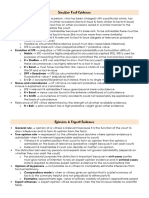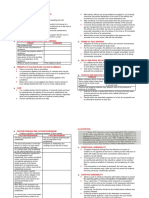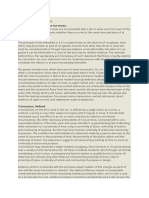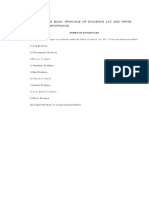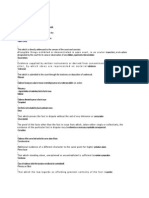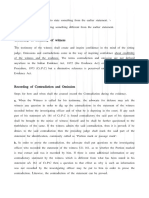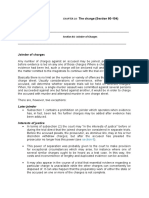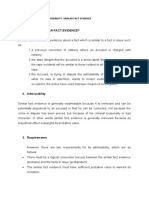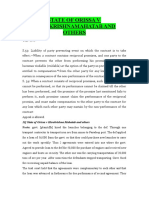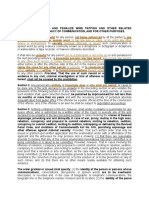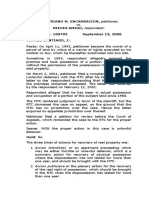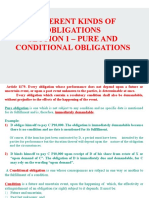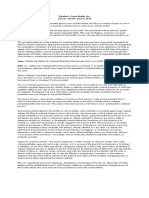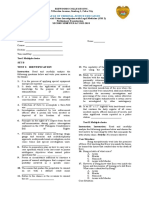Previous Consistent Statement
A previous consistent statement is a statement made by a person which is consistent
with (ie more or less the same as) a statement made by the same person during
testimony in court (or sometimes by another witness) offered in an attempt to
corroborate this person's testimony.
E.g. Make a statement at the scene of the crime without police (out of court) and
then make the same statement in court. It happens before the court case.
The statement may be made orally or in writing. The previous consistent statement is
not the statement that the witness makes in court, while giving evidence, but the
statement made previously.
Generally the only reason why evidence of a previous consistent statement is offered
in court is to support and strengthen (corroborate) the testimony of the maker of the
statement.
General Rule: Inadmissible
There are however 3 Exceptions Evidence of a previous consistent statement will be
admissible if it falls within one of these exceptions. If not, it cannot be admissible.
1. Complainant in a sexual case if the following circumstances present:
1. Must have been a physical assault;
2. Complaint must be made at the first reasonable opportunity
In S v Hammond 2004 (2) SACR 303 (SCA) the Supreme Court of Appeal stressed
that evidence of a complaint in a sexual case is admitted only in exceptional cases
as evidence of consistency in the account given by the complainant. It is therefore
admitted as a matter going to the complainant's credibility. It is not corroborative
evidence.
Where the accused, for example, alleges that no rape took place because the
complainant consented, evidence of the complainant does not amount to evidence of
lack of consent, nor its absence to evidence of consent. The complainant's testimony
in court is evidence of lack of consent, and evidence of the complaint does no more
than support the credibility of the complainant so testifying.
�The following requirements have to be satisfied for this exception to apply:
a) The exception applies to cases of a sexual nature if there has been some
degree of assault involved, or if the complainant was the victim of a sexual
offence which involved physical contact.
In the case of young children, however, no such physical contact is required.
Examples of offences where this exception is clearly applicable are rape,
indecent assault and incest. It does not matter whether the complainant is
male or female.
b) The second requirement the complaint must have been made at the first
reasonable opportunity. What this reasonable opportunity would be depends
on the circumstances of each individual case, and factors such as the age
and understanding of the complainant and whether contact was made with a
person in whom the complainant could confide. The trial court has to exercise
a discretion in this regard.
For instance In the case of S v Gouws, the court found it reasonable that a girl
who had been assaulted on the train only later told her mother and not the
ticket operator.
c) The third requirement the complaint need not have been made totally
spontaneously, but may not have been made after questioning which can be
considered intimidating or leading (ie putting the words in the complainant's
mouth).
Person does not have to admit spontaneously but mustn’t be intimidated/led
otherwise it will be negated.
In S v. T the the complainant's mother threatened to hit her with a stick if she
did not tell her who had sexually assaulted her. The daughter then identified
her stepfather. The court held that this was intimidation as the child was
threatened to point out who assaulted her. This evidence was excluded by the
court.
d) In the last requirement the complainant has to give evidence. In the absence
of any evidence by the complainant, the evidence will be inadmissible as
hearsay, unless it is found to be relevant for some purpose other than proving
the content of the complaint.
For example, in the case of S v. R – the Complainant arrived home drunk, and
told flatmate she was assaulted. She was drunk and could not remember
� telling the friend in court. The Flatmate was called in to relate the facts as an
exception and the evidence was ruled admissible.
2. TO REBUT AN ALLEGATION OF FABRICATION
To rebut an allegation of recent fabrication, think someone is fabricating may then
allow the previous consistent statement which is the same and therefore rebuts the
evidence of fabrication.
If it is suggested or alleged (mostly during cross-examination) that the witness has
recently fabricated a part of his evidence, evidence may be led to show that the
same thing was said at an earlier opportunity. This evidence is only tendered to
show that the witness did not recently fabricate the evidence, in order to support the
credibility of the witness. The evidence is therefore relevant for this purpose (to
support the witness's credibility), but not to corroborate the witness's evidence.
3. Prior identification
If someone has been identified in an identification parade prior to the trial. At the trial
they may say that is the accused I picked him out in the I.D. parade.
In summary, Evidence about previous consistent statements does not regularly
feature in our law of evidence. The rule against its admissibility applies in very
specific situations only, namely
(1) when, during testimony in court, a witness repeats a statement consistent with
one made on a previous occasion, in order to corroborate his evidence, and
(2) when a witness repeats a consistent statement made by another witness on a
previous occasion, which serves as self-corroboration for that other witness.
There are at least three exceptions to the basic rule that previous inconsistent
statements are inadmissible.














